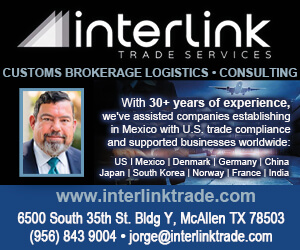
Texas Border Business
In the U.S., the “fracking” technology has dramatically lowered the cost of natural gas
As originally published by Texas Border Business newsprint Edition
Much has been said in the media about the resurgence of manufacturing in America, and the return of production that was previously sent to China. I have spoken with industry leaders from various global manufacturing companies about this. Most said they were primarily looking at the cost of doing business in China versus Mexico, rather than giving serious consideration about relocating back to the U.S.
For global corporations, the world is their stage. Some of the production being done offshore is actually consumed in the country where it is produced. Example: General Motors has assembly plants in China, but these vehicles are sold in China. Toyota and others have assembly plants in the U.S. and Mexico that make vehicles for sale in those markets.
Many factors go into the decisions about where to source production. Some of these include:
Availability of labor- especially skilled labor. The culture, acceptance of manufacturing as a good career choice, and the quality of the talent pipeline from K-16 impact this dramatically.
Labor cost differential (including payroll taxes and fringe benefits). Mexico is very competitive with China because of skilled labor shortages and rising labor rates there. The U.S. is not very competitive except in situations where plants can be heavily automated and operate with fewer employees.
Degree of automation in use- Investing in automation and new technology increases the output per employee and lowers the product cost. A tremendous number of jobs in manufacturing (and other sectors) have been eliminated by improvements in computers, software, operating systems, and by investing in automation. The good side of this is that heavily automated plants do not have a lot of people, and the higher U.S. labor costs are less of a deterrent for them to locate here.
Freight/transportation costs- The farther away from the customer, the higher the cost to move goods to their destination. When oil prices rise, transportation costs increase, so the higher the cost of oil, the more incentive there is to locate suppliers closer to assembly plants.
Response time/length of supply chain- The Tsunami in Asia wreaked havoc with some manufacturers because their suppliers had plants destroyed and the result was a production shutdown for weeks or longer. If there is a supplier quality problem, it takes much longer to recover and/or repair if the parts are made across the ocean.
Customer demands- An auto plant has a network of other manufacturers who make components and send them to the next tier supplier, who uses them to make a subassembly that is sent to the assembly plant. Most assembly plants want their suppliers located as close as possible to them, and they pressure suppliers to locate nearby.
Taxes and Regulatory climate- The corporate income tax rate, treatment of R&D expenses, lawsuit/legal climate, regulatory environment, and general attitude of government towards business all affect the cost of doing business and the risk associated with it.
Intellectual property protection- The degree of protection for intellectual property, and the available remedies varies widely around the globe. This is a big issue for some companies.
Energy Costs- In the U.S., the “fracking” technology has dramatically lowered the cost of natural gas. Since natural gas is used for much of our electricity generation, the cost of electricity has dropped dramatically. This is a major cost for many manufacturers who have a lot of machinery (and fewer people), and an even bigger value for the chemical and plastics industries that use natural gas as their primary raw material. This is why we are seeing billions of dollars being invested in new energy and chemical plants around the Texas Gulf coast.
As you can see, there are many moving parts to the puzzle when companies make decisions about where to locate their factories. Cost, reliability of deliveries, availability of talent, and regulatory climate all factor into these decisions. It is not really about patriotism- if a company does not keep its costs competitive globally, they will not survive, and all of their jobs will disappear. Companies are not in business to create jobs- jobs are the byproduct of a growing company who is meeting the needs of their customer.















